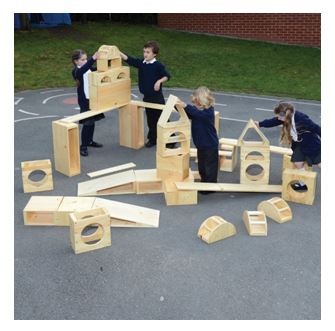
The revised EYFS 2012 identifies three key prime areas of children’s early development – physical; personal, social and emotional; communication and language.
Block Play is an intrinsic part of early years development, covering a multitude of the key prime areas, but a child’s ability to have fun and express themselves through play should be considered to be just as important. Hollow Blocks are perfect for this, allowing children’s imagination to guide their play. With no prescribed method or expected outcome, children feel free to have a go, experimenting with the shapes, sizes and weights of each block. With hollow blocks, imagination flourishes, ideas multiply and confidence blossoms.
Because hollow blocks are purposefully detail-free, they allow a child’s imagination to roam free. Each experiment encourages the next, and allows children to grow in confidence and develop creative thought. Hollow blocks allow children to experience shape and spatial orientation on a larger scale than traditional, indoor classroom furniture. Hollow Blocks also enable children to develop social skills through cooperative play; students learn how to interact by speaking and listening to each other, sharing ideas and making use of the resources they have available to them.
Hollow Blocks allow children to develop spatial awareness as they construct blocks to fit in the space around them. Large motor co-ordination is refined with the larger blocks whilst the smaller, more intricate, blocks allow for the development of fine motor co-ordination. Shape recognition and hand-eye co-ordination are also developed through this kind of play – both of which are the fundamental building blocks for preparing children for the physical aspect of writing.
Many other subjects are supported through Hollow Block play, Maths being a prime example. During play, the children may begin to count and sort the blocks as they place them into lines or balance the blocks on top of each other. In this sense, Hollow Blocks also begin to teach the basics of technical concepts such as design and symmetry. They even provide a rudimentary understanding of basic elements of physics – as blocks fall over and structures have to be reconstructed, children begin to grasp complex forces such as gravity and weight.
By playing with Hollow Blocks, children learn to take risks by building bigger and bigger constructions. They learn how to cope with emotion, for example dealing with frustration when their tower collapses and then using that frustration as determination and perseverance to start again.
For the youngest children, Hollow Blocks provide a tactile experience of holding, carrying and feeling the shapes of each block.
So the versatile Hollow Blocks can provide a wealth of stimulating learning activities – educating and developing the children whilst they are having fun. For more information on our Hollow Blocks range, please visit our dedicated product page; you can also see our wider construction lines here.
Originally written 10 September 2015